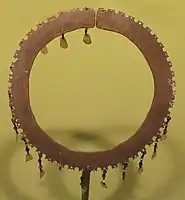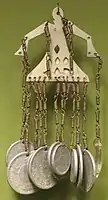Bugkalot
The Bugkalot (also Ilongot or Ibilao[1]) are a tribe inhabiting the southern Sierra Madre and Caraballo Mountains, on the east side of Luzon in the Philippines, primarily in the provinces of Nueva Vizcaya and Nueva Ecija and along the mountain border between the provinces of Quirino and Aurora. They are also commonly referred to as "Ilongot", especially in older studies, but nowadays, the endonym Bugkalot is preferred in modern ethnic research.[2] They were formerly headhunters.[3]
 A Bugkalot man at work in clearing (c. 1910). | |
| Total population | |
|---|---|
| 87,000 | |
| Regions with significant populations | |
(Nueva Vizcaya, Nueva Ecija, Quirino, Aurora, Northern Luzon) | |
| Languages | |
| Bugkalot, Ilocano, Tagalog, English | |
| Religion | |
| Animism, Paganism, minority Christianity | |
| Related ethnic groups | |
| Igorots, Ibanag, Ilocano, other Filipino ethnic groups, Austronesian peoples |

Presently, there are about 87,000 Bugkalots.[4] The Bugkalots tend to inhabit areas close to rivers, as they provide a food source and a means for transportation. Their native language is the Ilongot language, currently spoken by about 50,000 people. They also speak the Ilocano language.
Culture


In Ivan Salva's study in 1980 of the Bugkalots, she described "gender differences related to the positive cultural value placed on adventure, travel, and knowledge of the external world." Bugkalot men, more often than women, visited distant places. They acquired knowledge of the outside world, amassed experiences there, and returned to share their knowledge, adventures, and feelings in a public oratory in order to pass on their knowledge to others. The Bugkalot men received acclaim as a result of their experiences. Because they lacked external experience on which to base knowledge and expression, Bugkalot women had inferior prestige.
Based on Michelle Rosaldo's study and findings of other stateless societies, anthropologists must distinguish between prestige systems and actual power within a society. Just because a male has a high level of prestige, he may not own much economic or political power compared to others that are less prestigious within the society.
Renato Rosaldo went on to study headhunting among the Bugkalots in his book Ilongot Headhunting, 1883-1974: A Study in Society and History. He notes headhunting raids are often associated with bereavement, a rage, and expiation at the loss of a loved one.
Indigenous religion

- Delan: deity of the moon, worshiped with the sun and stars; congenial with Elag; during quarrels, Elag sometimes covers Delan's face, causing the different phases of the moon; giver of light and growth[6]
- Elag: deity of the sun, worshiped with the moon and stars; has a magnificent house in the sky realm called Gacay; retreats to his home during nights; giver of light and growth[7]
- Pandac: deity of the stars, worshiped with the sun and moon; giver of light and growth[8]
- Cain: the headhunter creator of mankind; gave customs to the people; lived together with Abel in the sky but separated due to a quarrel[9]
- Abel: prayed to when wishing long lives for children; lived together with Cain in the sky but separated due to a quarrel[10]
- Keat: personification of lightning, depicted as the road of Cain and Abel[11]
- Kidu: personification of thunder, which follows Keat[12]
- Gemang: guardian of wild beasts[13]
- Oden: deity of the rain, worshiped for its life-giving waters[14]
- Tawen: personification of the sky[15]
- Kalao: spirit birds;[16] depicted as red hornbills who guide and protect hunters and their soul[17]
- Be'tang: unpredictable shape-shifting spirit-creatures living in the forests or wilderness called Gongot; youth and softness are their properties, while they can also alter a human's sense of time; they may take the form of a white dog, a large deer, a horse with a hanging tongue, a naked woman, or beings with grotesque shapes, whose attributes range from long arms and legs, small heads, oversized feet, fur bodies, to hairless bodies; they may also enter a person's dreams or paralyze a human[18]
- Ga'ek Spirits: spirits in the Ga'ek magic plant used in for hunting and fishing; the naw-naw prayer is given to them[19]
Gallery of Bugkalot art
 A headdress made of horn bill, shell, wire, rattan and hair
A headdress made of horn bill, shell, wire, rattan and hair A bracelet made of brass, beads and mother of pearl
A bracelet made of brass, beads and mother of pearl A necklace made of brass, mother-of-pearl and beads
A necklace made of brass, mother-of-pearl and beads Men's ear pendants made of hornbill, discs of shell, beads and brass
Men's ear pendants made of hornbill, discs of shell, beads and brass Earrings made of shell, brass and beads
Earrings made of shell, brass and beads A hair ornament
A hair ornament A pendant made of Japanese coins, brass, aluminum and glass
A pendant made of Japanese coins, brass, aluminum and glass_from_Ilongot_in_northern_Luzon%252C_hornbill%252C_brass%252C_shell_and_cotton%252C_Honolulu.JPG.webp) Men's ear pendants (batling) made of hornbill, brass, shell and cotton
Men's ear pendants (batling) made of hornbill, brass, shell and cotton
References
- Barrows, David P. (December 1910). "The Ilongot or Ibilao of Luzon". Popular Science Monthly.
- Mikkelsen, H. H. (2016). Chaosmology: Shamanism and personhood among the Bugkalot. HAU Journal of Ethnographic Theory.
- Mikkelsen, H. H. (2016). Chaosmology: Shamanism and personhood among the Bugkalot. HAU Journal of Ethnographic Theory.
- https://joshuaproject.net/people_groups/12214/RP
- "Cutting Cosmos: Masculinity and Spectacular Events among the Bugkalot" (2018), Henrik Hvenegaard Mikkelsen, ISBN 978-1785337703
- Wilson, L. L. (1947). Ilongot Life and Legends. Southeast Asia Institute.
- Wilson, L. L. (1947). Ilongot Life and Legends. Southeast Asia Institute.
- Wilson, L. L. (1947). Ilongot Life and Legends. Southeast Asia Institute.
- Wilson, L. L. (1947). Ilongot Life and Legends. Southeast Asia Institute.
- Wilson, L. L. (1947). Ilongot Life and Legends. Southeast Asia Institute.
- Wilson, L. L. (1947). Ilongot Life and Legends. Southeast Asia Institute.
- Wilson, L. L. (1947). Ilongot Life and Legends. Southeast Asia Institute.
- Wilson, L. L. (1947). Ilongot Life and Legends. Southeast Asia Institute.
- Wilson, L. L. (1947). Ilongot Life and Legends. Southeast Asia Institute.
- Wilson, L. L. (1947). Ilongot Life and Legends. Southeast Asia Institute.
- Wilson, L. L. (1947). Ilongot Life and Legends. Southeast Asia Institute.
- Carlson, S. E. (2014). From the Philippines to The Field Museum: A Study of Ilongot (Bugkalot) Personal Adornment. Illinois Wesleyan University.
- Mikkelsen, H. H. (2016). Chaosmology: Shamanism and personhood among the Bugkalot. HAU Journal of Ethnographic Theory.
- Mikkelsen, H. H. (2016). Chaosmology: Shamanism and personhood among the Bugkalot. HAU Journal of Ethnographic Theory.
- Phillip, Conrad. (2005). Window on Humanity. New York: McGraw-Hill
- Rosaldo, Michelle Zimbalist, Lamphere Louise. A Mulher. A Cultura e a Sociedade. ("Woman. The Culture and Society") Brazil: RJ. Paz e Terra, 1979. Coleção O Mundo hoje. ("The world today") 31. p. 58.
- Rosaldo, Renato. from Culture and Truth: The Remaking of Social Analysis. "Introduction: Grief and a Headhunter's Rage" (pp. 1–21).
External links
| Wikimedia Commons has media related to Ilongot. |
- Bugkalot
- NPR Listen to: High Voltage (Emotions Part 2) - Liget